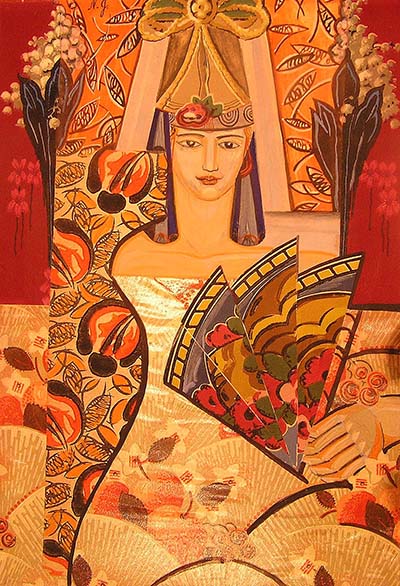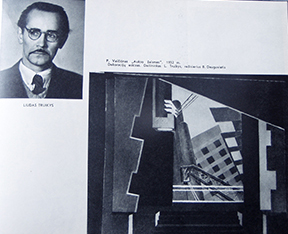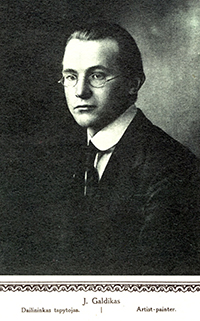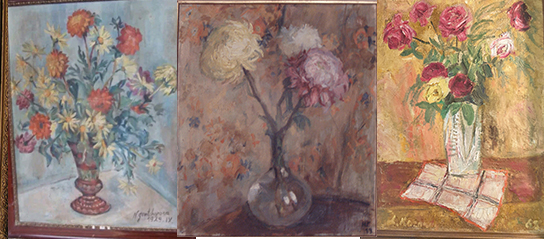The Search Go On! War and Reminiscence. Part 5

Company: Mail Boxes Etc. 005 Levallois-Perret
Z. Varnauskas mostly liked to tell about A. Galdikas and L. Truikys. With the respect he always told about A. Galdikas, with respect, but with irony, he told about L. Truikys. It was very interesting because I had one idea. L. Truikys was a famous Lithuanian Theatre artist and had a very interesting Lithuanian folk art and east art collection. He lived close to my mother’s house and I saw every day when he went for a walk. I was a child age 11. Anyone can see L. Truikys collection now. L. Truikys and M. Rakauskaite house-museum. E. Fryko str. 14-2. Kaunas 44229, Lithuania. I lived close to L. Truikys house has never been in there. Varnauskas often told how he exchanged paintings with L Truikys. Here was his favorite topic. The people of this generation highly appreciated the old Japanese woodblock prints. I found out that Varnauskas loved it. Also, he haughtily appreciated Galdikas art. My idea was to find more of what Varnauskas liked and swap it to Russian art which he did not like.
Liudas Truikys ( Lithuanian artist and art collector 1904-1987)

Liudas Truikys studied at Kaunas Art School, but also in Paris and Berlin, where he developed his skills as a set-designer. In Kaunas, he became involved in the Independent Group of Lithuanian artists and, in 1936, joined the Lithuanian Artists’ Union. It was during Truikys’s time at the Lithuanian National Theatre that he met the American-born soprano Marijona Rakauskaite, a rising star at the State Theatre who would go on to create over thirty roles.
The house that is now the Liudas Truikys and Marijona Rakauskaite Museum was built in the 1940s and the couple moved in soon afterwards. They would remain here until the end of their lives. It opened to the public after their deaths, in 1994, and displays paintings, decorative work and designs by Truikys alongside a selection of Rakauskaite’s stage clothes. Visitors can also see the couple’s extensive collection of Lithuanian folk art, particularly sculpture, and Asian art, important sources of influence and inspiration on them both.
Adomas Galdikas ( Lithuanian artist, art collector 1893 – 1969)

Galdikas attended painting studios in Saint Petersburg and Berlin. Galdikas continued his studies in Sweden, Italy and France. In 1923, after returning to Lithuania, he founded his own graphics studio in Kaunas, where he worked until 1940. At the same time he was also lecturing at the Kaunas Art School. During World War II Galdikas was a professor at the Kaunas Applied Arts Institute. Vytautas Kazimieras Jonynas was among his students. From 1946 to 1947 Galdikas lectured as a professor in Freiburg im Breisgau (École des Arts et Métiers). In 1947 Galdikas moved to Paris, and in 1952 to the United States. He settled in New York, where he lived until his death.
Basically everyone old generation artist, theatre director, writer, and representatives of the intelligentsia had an art collection (in Lithuania).
Mother’s friend Janina often visited the guests when I was a child. We lived in Sanciai, Krantas aleja (Bank alley, district Kaunas) and Janina lived at the end of the same street. We moved from Sanciai to Zaliakalnis when I was age 11. Janina got to visit us in our new home every week. Janina was an educated woman from a famous family of artists, her husband was also a famous artist. She has great adherence to etiquette. We kids didn’t like it very much. Various comments at the table: how to sit, with which table tool to eat, how to use it correctly, how to eat… Once I asked Janina (I was age 11), why we never didn’t visit or invited guest L. Truikys. How we can go, she told me, we can’t go to visit him, what he will say when he sees my neck (Janina was 72) Janina was a beautiful woman in her youth. She married famous Lithuanian artist A. Valeska and they were friends with Truikys family. She was from the famous artist Kazokas family. They had a nice art collection at home.

Janina in photos and paintings on the left image. Second image in our house in Sanciai, I am here age 5 in the front.
Leonardas Kazokas (Kazakevitch) (Lithuanian artist 1905-1981) Janina brother.
Leonardas Kazokas, a painter and teacher, was born on 27 July 1905 in Kaunas. He attended the Kaunas School of Art between 1922 and 1929, and completed his studies under J. Vienožinskis. He began to participate in exhibitions in 1929. He was a member and chairman of the Independent Artists’ Society. He left for Paris in 1930 to continue his studies. When he returned to Kaunas (1934–1939), he taught drawing at the Third Gymnasium of Kaunas. He gave drawing classes in Vilnius in 1940 and 1941, and at the Kaunas Institute of Applied Art from 1944 to 1951. He travelled extensively during his summer holidays. Between 1934 and 1938 he visited Sweden, Norway, Belgium, France, England and East Prussia. From 1951 to 1961, he worked as an artist at the Dailė art factory in Kaunas.
Adolfas Valeska (Lithuanina/American artist, art collector 1905-1994) Janina husband.
Adolfas Valeška (15 March 1905, Kybartai – 11 May 1994, Kaunas, Lithuania) was a Lithuanian stained glass artist, painter, stage designer, and museum director who worked in Lithuania and in Chicago, Illinois.
Valeška graduated from the Kaunas Art School in 1928. He then began work as a church decorator, moving on to co-found a museum of religious art in Kaunas. From 1939 to 1944 he served as director of the Vilnius Art Museum. During this period his work was exhibited in a number of venues, including the International Exhibition of Decorative Arts in Paris, 1935; the International Press Exhibition at the Vatican, 1935; and the International Exhibition of Decorative Arts in Berlin, 1937, where he earned a medal for designing the Lithuanian Pavilion.
Anticipating the Soviet occupation of Lithuania at the end of World War II, in 1944 he emigrated first to West Germany and then to the United States, where he established a studio in Chicago. He designed and executed a number of stained glass works and mosaics, as well as acting as a stage designer for the Lithuanian Opera Company of Chicago After Lithuania regained its independence in 1990, he returned to the country of his birth, where he died at the age of 89 in 1994. He took an art collection from Chicago and left it to his daughter in Lithuania.
Rita Pancerova (Valeskaite) (art collection keeper 1932-2018) Janina and Valeska daughter.
I will write later About Valeska collection.

In this section, I would like to go back to the distant past. This has nothing to do with art collection. But some events, what happened 1991., return me back to art history.
After graduating from the academy, I received a bachelor’s degree in art history. But I realized that it is impossible to make a living from art. Like most Lithuanians, I was open for business. With the collapse of the Soviet Union, it became possible to travel abroad.
The first foreign country was Poland, where we were able to travel. Here it was possible to buy goods and sell them in Lithuania. The distance is short and the profit is not bad.
Everything has changed as the opportunity to travel to Yugoslavia has arisen. There were real gold mines here.
All you had to do was buy goods (food, tools, clothes, household items, etc.) and transport them to Yugoslavia. Profit on sale 1000%. The journeys were long (about 2,600 kilometers one way) and dangerous (banditry raged in Polish territory, traveling cars were brutally stopped, money and belongings were taken away. Bandits were from Russia and Ukraine. They were brutal, armed, and many people were killed). After passing through the territory of Poland, about 750 kilometers were safer. There were also very bad roads in Poland, with many car accidents. You could feel safe when you arrived in Hungary. Travel risk was recouped by profits. After two such commercial trips, you were able to buy a new car in Lithuania.
But unfortunately this business ended abruptly. The war broke out in 1991. I was just at the time I was traveling home through Serbian territory. I needed to get Hungary to rest there and at the same time cross the rest of the countries (Hungary, Slovakia), cross the territory of Poland and drive through Lithuania. I saw soldiers and tanks while driving, but it didn’t bother me too much (we were seeing lots of Russian tanks and soldiers when Lithuania announced its withdrawal from the Soviet Union in 1989) When I reached the territory of Croatia, I was greeted by a military cordon.
The Croatian War of Independence (Croatian Domovinski rat ‘Homeland War’) is a war that took place between 1991 and 1995. Between the Yugoslav People’s Army under the Serb-dominated Yugoslav government, supported by Croatian Serbs, and the Croatian government.
Croatia (former part of the Socialist Federal Republic of Yugoslavia) sought to declare an international recognition of the Republic of Croatia, while Serbia sought to establish new border variants in parts of Croatia, in many or strong small constituencies and in separate places from Croatia, respectively. Serbian leader Milosevic was accused of trying to create a Greater Serbia by uniting all Serbs. 1991-1995, a four-year war in a relatively developed place in a European country was very brutal.
It was controlled by the Serbian army. The cordon was based near a bridge through the Danube river. Nobody has been allowed to cross the bridge. I talked to the soldiers, explained the situation, said I was going home and they allowed me to go. I was greeted by another cordon when I crossed the river. There was Croatian army. They let me go when I explained the situation (I didn’t know yet when I would have to cross these cordons again). I was left to reach Hungary which was about 1 hour away. I had a flat tire when I approached a small town. Good thing I had a spare wheel. I jacked up the car and took off the wheel. Suddenly a police van approached. The officer asked me what I was doing here. The next question was asked in a strict tone – why I was in Serbia. The police officer was not happy with my answer, he took the spare wheel and threw down a wheel from the mountain. When I asked him why he did this, he slammed a gun over my head, locked my hands with handcuffs, and threw me into the van. I spent the night in custody. The interrogation began in the morning.
They questioned me for a long time, tried to scare me. They took the Kalashnikov submachine-gun and said they would shoot me. And then I was released. Police told me my car is around 20 kilometers from here. I walked to the road where there was a crossroads. There were three signs pointing in different directions. 18 km, 18km, and 19 km. Unfortunately, I didn’t know the name of the small town where my car was.
I took one direction. I was not ready for the walk, my shoes were a massage slipper and 40 degrees hot outside. No water, no money. I start to go and after 3 hours I reach the destination. But here was not the correct town which I needed. I turn around and go back. After another 3 hours I saw the police station where I have been before. I didn’t know what I’d be stuck here for six months …
To be continued…